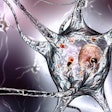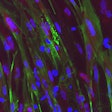
University of Minnesota researchers are working on a diagnostic test that may allow faster and more accurate detection of neurodegenerative diseases.
They described the technique in a study, published recently in Nano Letters, saying it may open doors for earlier treatment and mitigation of various diseases that affect humans, such as Alzheimer's and Parkinson's, as well as similar diseases that affect other animals, including mad cow disease and chronic wasting disease.
Neurodegenerative diseases such as Alzheimer's, Parkinson's, mad cow, and chronic wasting disease (widely found in deer) share a common feature: the buildup of misfolded proteins in the central nervous system. Detecting these misfolded proteins is crucial for understanding and diagnosing these devastating disorders. However, current diagnostic methods, such as enzyme-linked immunosorbent assay (ELISA) and immunohistochemistry, can be expensive, time-consuming, and limiting in terms of antibody specificity, making testing for neurodegenerative diseases in both animals and humans a major challenge.
An advanced protein-misfolding detection method, called the Rocky Mountain Laboratories’ Real-Time Quaking-Induced Conversion (RT-QuIC) assay, involves shaking a mixture of normal proteins with a small amount of misfolded protein, triggering a chain reaction that causes the proteins to multiply, and allows for the detection of these irregular proteins. However, RT-QuIC has a typical 14-hour detection cycle, meaning that lab staff can generally run only one test per normal working day.
The researchers’ method, dubbed the Nanoparticle-enhanced Quaking-Induced Conversion (Nano-QuIC), significantly improved upon the performance of RT-QuIC. Using tissue samples from deer, the team demonstrated that adding 50-nanometer silica nanoparticles to RT-QuIC experiments increased the sensitivity by a factor of 10, and reduced detection times from 14 hours to less than four hours. Given this reduced detection time, researchers can now run three or four tests per day.
Having a rapid and highly accurate detection method is particularly important for understanding and controlling the transmission of chronic wasting disease, which is spreading throughout deer across North America, Scandinavia, and South Korea.
The researchers said they believe that Nano-QuIC could eventually prove useful for detecting protein-misfolding diseases in humans, specifically Parkinson's, Creutzfeldt-Jakob disease, Alzheimer's disease, and amyotrophic lateral sclerosis (ALS).
Senior co-author Sang-Hyun Oh co-leads the University’s Minnesota Center for Prion Research and Outreach, which leverages government funding to conduct research on protein misfolding diseases. “Ultimately our goal is to expand the technology for a broad spectrum of neurodegenerative diseases, Alzheimer’s and Parkinson’s being the two main targets,” said Oh, who is also a professor of electrical and computer engineering at the University of Minnesota. “Our vision is to develop ultra-sensitive, powerful diagnostic techniques for a variety of neurodegenerative diseases so that we can detect biomarkers early on, perhaps allowing more time for the deployment of therapeutic agents that can slow down the disease progression. We want to help improve the lives of millions of people affected by neurodegenerative diseases.”



















